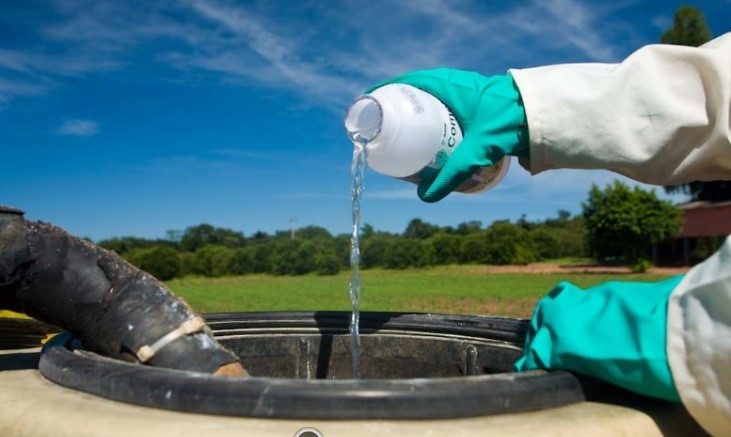“Currently, farmers must be guided on the correct use of pesticides and the maintenance and calibration of sprayers…”
Matheus Rakes is a researcher at ProtTech Crop Services, an agronomist with a master’s degree from the Federal University of Pelotas, and a Ph.D. candidate in Plant Health with an emphasis on Entomology.

Matheus Rakes, researcher at ProtTech Crop Services
AgriBrasilis – What are the benefits of mixing pesticides on the spray tank?
Matheus Rakes – First, we need to understand what tank mixes are. Tank mixes are defined as the combination of pesticides (different commercial products) and related products (e.g. adjuvants, fertilizers, etc.) in the tank of the application equipment, immediately before application. Therefore, speaking exclusively of advantages, the recommendation of tank mixes is mainly aimed at operational advantages, due to cost reductions, reduced number of machinery entries in the area and fuel savings. In addition, tank mixes are recommended in an attempt to increase the spectrum of control of arthropod pests, phytopathogens and weeds.
AgriBrasilis -Who is authorized to recommend this practice in Brazil?
Matheus Rakes – In 2018, a Technical Cooperation Agreement was signed between the Secretariat of Agricultural Defense – SDA/MAPA; and the Federal Council of Engineering and Agronomy – CONFEA, which published Normative Instruction No. 40. In view of this, in its six articles, IN 40 once again allowed mixtures of pesticides and similar products in tanks and established criteria and procedures to allow professionals to recommend mixtures of pesticides and similar products in tanks and their agronomic prescriptions.
Currently, farmers must be guided on the correct use of pesticides and the maintenance and calibration of sprayers, in addition to receiving technical assistance to reduce environmental contamination and increase operational efficiency.
AgriBrasilis – Is there a “synergistic effect” of these mixtures for pest control?
Matheus Rakes – A synergistic interaction occurs when the mixture of products presents better/greater results than the application of each one separately, that is, the application of an isolated product, with 40% efficacy, when mixed with another with the same % efficacy, the control reaches 100%. Dealing exclusively with mixtures of agrochemicals (different commercial products) and similar, directly in the tank, few (and inconclusive) studies have evaluated such interactions in the management of arthropod pests.
AgriBrasilis – What are the pros and cons of tank mixing for managing pests in the farms?
Matheus Rakes – It is important to focus not on the pros and cons, but on the precautions that we must take when tank mixing for the management of pests, especially in the case of arthropods. This technique requires prior knowledge regarding the compatibility of products with different active ingredients and formulations in mixtures, with a view to preventing possible adverse effects.
There are at least two types of incompatibilities that can occur in tank mixing, which are: (i) physical incompatibilities, which correspond to the formation of precipitates or granules, for example; (ii) chemical incompatibilities, which are mainly related to significant changes in the hydrogen potential (pH) and electrical conductivity (EC).
Physical incompatibilities can result, for example, from the formation of precipitates or phase separation, which in the worst case scenario can result in the clogging of equipment nozzles and filters during application, depending on the size of the particles formed. Physical incompatibilities can be easily observed in practice using the bottle test.
Chemical incompatibilities can cause, for example, molecular complexations that, in turn, alter the characteristics of the active ingredients. Mixtures that substantially alter the pH and EC can cause, for example, ionic dissociation and reduced solubility (when at extremely acidic pH values); or the occurrence of alkaline hydrolysis, in cases of changes that raise the pH.
In turn, EC is related to the absorption and translocation capacity of the active ingredient in the plant, an extremely important factor when it comes to fungicides, herbicides and insecticides with systemic action on plants. In addition to the precautions regarding possible incompatibilities, attention must be paid to the order in which the products are added, considering their formulations; in this case, the order of the factors alters the product.
Products with lower solubility in water should be added first (always agitating the tank while making the mixture). Furthermore, water quality is another factor that should be analyzed when mixing pesticides in the spray tank, due to the amount of other ions that compose it and that are not constituents of hardness. Last but not least, biological compatibility, when using biological products, must be known when mixing such products in the spray tank (More details in: Ribeiro et al., 2024; Rakes et al., 2024, 2025; Sperotto et al., 2025).
AgriBrasilis – What is the bottle test and what is it used for?
Matheus Rakes – The bottle test is a simple and practical assessment used to identify possible incompatibilities between products that will be mixed in the spray tank. It consists of combining the products in the recommended order in a transparent bottle with water in the same proportion as in the field application, shaking and observing the mixture after the static period. Visual changes that indicate instability are observed, such as precipitation, flocculation, phase separation or formation of foam, lumps, among others.
The assessment of physical incompatibility is based on a scale of grades, generally from 1 to 5, assigned according to the time required for phase separation. Mixtures that present immediate separation (grade 1) or within 1 minute (grade 2) are considered incompatible and are not recommended for use. Separations between 5 and 10 minutes (grades 3 and 4) indicate partial compatibility, requiring constant agitation during application. Chemical assessments can be performed more practically using a pH meter and pocket conductivity meter. This approach allows for the anticipation of operational and agronomic problems, promoting safety and effectiveness in spraying.
AgriBrasilis – Is there a proven dislodging effect for mixtures with foliar fertilizers?
Matheus Rakes – In recent years, there has been an increase in the use of nutrient-based products (macro and micro), often registered as foliar fertilizers, but used in the field to promote the displacement of arthropod pests. Although they are not officially registered as pesticides, these products are applied with the aim of interfering with the behavior of insects, promoting their movement or falling from the plant, which can aid in management.
For example, Morais et al. (2024), when studying, under field conditions, binary mixtures in a spray tank of synthetic insecticides with foliar fertilizers, did not identify increases in control efficacy, as well as in corn productivity, aiming at the control of the green-bellied barnacle Diceraeus spp. In addition, in some cases, chemical incompatibilities (mixtures in which the pH of the spray was greater than 9) and physical incompatibilities (mainly phase separation) were observed, to which in these treatments, the control efficacy values were reduced by half. It is worth mentioning that studies aiming to evaluate the dislodging effect in mixtures with insecticides are scarce and, under no circumstances, these results should be generalized, considering that there are significant differences in the effects varying between genera and life stage of the insect.
Recommended literature:
Morais, M. C., Rakes, M., Balzan, F., Grützmacher, A. D., Bernardi, D., & Ribeiro, L. D. P. (2024). Effects of mixtures of arrestants, dislodgers, and phagostimulants with synthetic insecticides on green-belly stink bug: walking behavior assessments, physicochemical interactions, and laboratory and field trials. Journal of Economic Entomology, 117(1), 167-177.
Ribeiro, LP., Amandio, D. T. T., Rakes, M., Belegante, F., Moresco, C., Nesi, C. N., … & Zanardi, O. Z. (2023). Insecticides for corn leafhopper management versus entomopathogenic fungal isolates: In vitro compatibility, physical-chemical interactions, and on-farm assessments. Crop Protection, 174, 106417.
Rakes, M., Morais, M. C., Sperotto, M. E., Zanardi, O. Z., Palma, G. R., Floriano, L., … & Ribeiro, L. D. P. (2025). Fungicides vs mycoinsecticides in the management of corn leafhopper: physicochemical, in vitro and in vivo compatibilities, and degradation kinetics in maize plants. arXiv preprint arXiv:2503.21606.
Rakes, M., Morais, M. C., Sperotto, M. E., Zanardi, O. Z., Bernardi, D., Anderson, D. G., & do Prado Ribeiro, L. (2024). Toxicity of Post-Emergent Herbicides on Entomopathogenic Fungi Used in the Management of Corn Leafhopper: In Vitro and In Vivo Assessments. Agriculture, 14(12), 2189.
Sperotto, M. E., Rakes, M., Morais, M. C., Bernardi, D., & do Prado Ribeiro, L. (2025). In vitro and in vivo compatibility of isocycloseram-based insecticides with entomopathogenic fungi used for corn leafhopper management. Crop Protection, 194, 107204.
LEIA MAIS:

